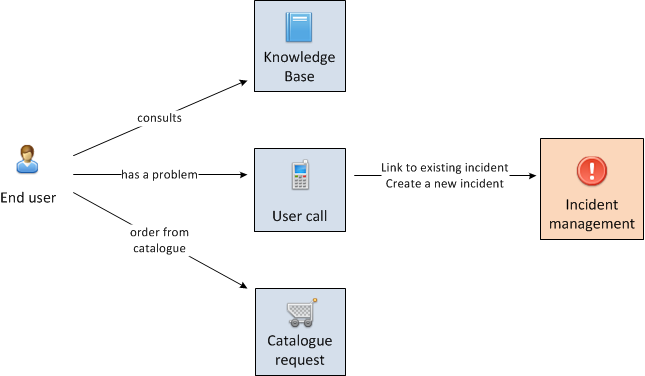Request fulfillment - Service Desk
The objective of the Request fulfillment process is:
- To provide users with a channel for requesting standard services, for which a defined approval process is defined (catalogue requests).
- To provide users and customers with information about service availability and process of their acquiring.
- To ensure and deliver components of standard services (e.g. licenses).
- To help with general questions, complaints and comments.
ObjectGears provides above stated objectives by the help of two models:
Model Request contains Service desk portal, that is a central point for the users. It leads the user to report a problem he/she faces (entity User call) or to request a standard service from a catalogue (entity Catalogue request). It also offers the user information about the most frequent problems and other information from Knowledge Base.
The users have basic overviews of their open calls or catalogue request at disposal on this portal. There is a special section with calls and catalogue requests that wait for user response. There are also overviews of all the calls and requests of the user and an overview of metrics of these calls and requests.
Model Knowledge base enables to create articles and their look up by users. This model offers article categorization, information classification, approval of articles before publishing, fulltext search and link to Configuration management by references to configuration items.

User call can lead to an Incident creation, that is done by a Service desk staff or by a Solver, to whom the User Call was assigned, or to linking the User call to en existing Incident, that is assigned to resolution. Incident creation is facilitated by an automatic take over of basic information from the entity User call into the created Incident. Advantage of separating these two entities is elimination of incident duplication, which is caused by more users reporting the same issue, and creation of only such incidents that really are incidents. (Smaller organizations sometimes prefer only one entity (Incident), in which end users create records directly. In such a case the model is simply adjusted within implementation.)
Catalogue request is a special case of Change management process, that is used for a standardized changes, where approval process is known in advance. Various roles may take part on this approval process - e.g. manager, owner of the catague service, owner of the budget from which the service is paid.
Examples of screens
Service desk portal
Service desk portal provides users with access to knowledge base and possibility to report bugs and issues and order catalogue items. There are both overviews of open items and all previous already closed request for each user. On the right there are visualized main statistics of the service desk - both from the perspective of the particular user and from the perspective of an overall fulfilment of all user requests. There are also various reports and an overview of planned system outages.